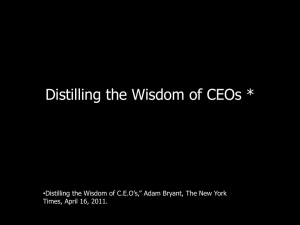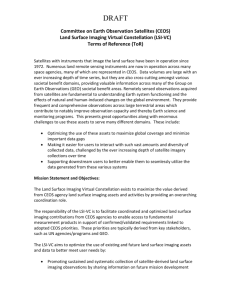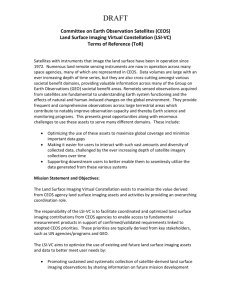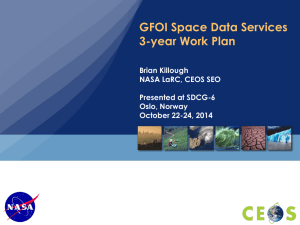Discussion Document
advertisement
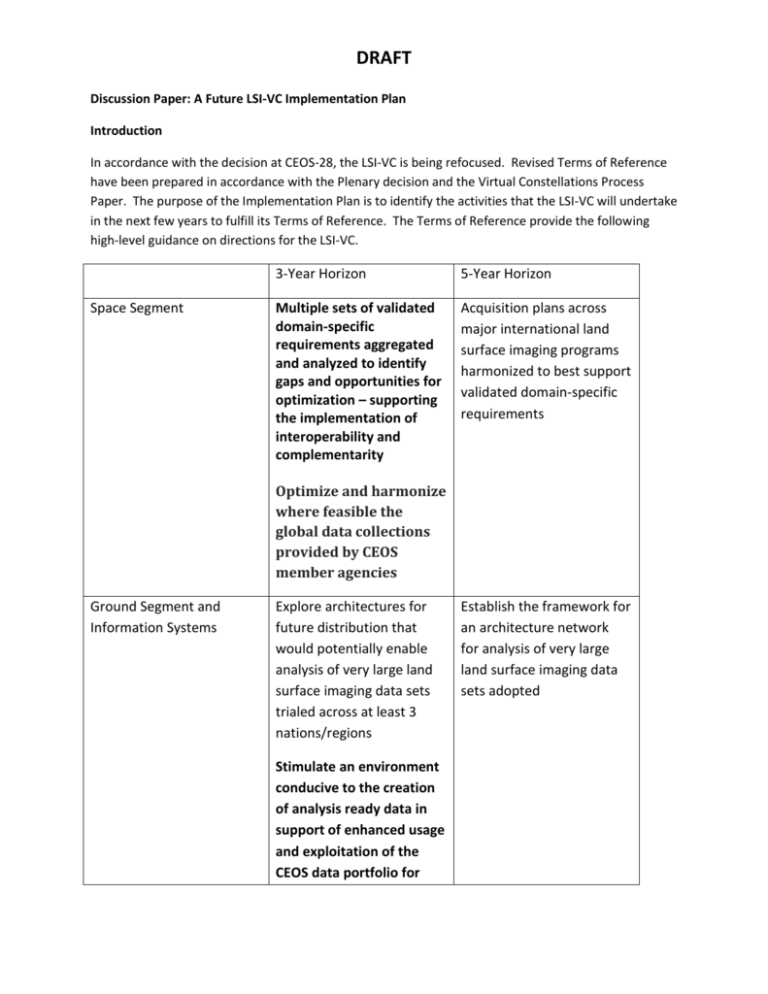
DRAFT Discussion Paper: A Future LSI-VC Implementation Plan Introduction In accordance with the decision at CEOS-28, the LSI-VC is being refocused. Revised Terms of Reference have been prepared in accordance with the Plenary decision and the Virtual Constellations Process Paper. The purpose of the Implementation Plan is to identify the activities that the LSI-VC will undertake in the next few years to fulfill its Terms of Reference. The Terms of Reference provide the following high-level guidance on directions for the LSI-VC. Space Segment 3-Year Horizon 5-Year Horizon Multiple sets of validated domain-specific requirements aggregated and analyzed to identify gaps and opportunities for optimization – supporting the implementation of interoperability and complementarity Acquisition plans across major international land surface imaging programs harmonized to best support validated domain-specific requirements Optimize and harmonize where feasible the global data collections provided by CEOS member agencies Ground Segment and Information Systems Explore architectures for future distribution that would potentially enable analysis of very large land surface imaging data sets trialed across at least 3 nations/regions Stimulate an environment conducive to the creation of analysis ready data in support of enhanced usage and exploitation of the CEOS data portfolio for Establish the framework for an architecture network for analysis of very large land surface imaging data sets adopted DRAFT land surface imaging Products and Services 1-2 compatible non-domain specific measurement products, derived from 1 sensor, being produced by multiple Agency systems 4-5 compatible non-domain specific measurement products, derived from 3-4 sensors, being produced by multiple Agency systems The purpose of this discussion paper is to socialize the proposed implementation activities of LSI-VC for the next three years, working towards the 3-Year Horizon in the Terms of Reference. In preparing this discussion paper consideration has been given to: The desire to address ‘pressing issues’ of strategic concern to CEOS and CEOS Agencies. The need to work with the resources that agencies can realistically provide. The need to re-build momentum by implementing solutions that work, thereby encouraging further agencies to buy-in and contribute. The desire, and need, to ensure strong linkages with other CEOS Entities. This builds on the linkages identified in the Terms of Reference. Proposed Focus It is proposed that LSI-VC effort be focused on developing and implementing coordinated solutions across the following four themes: Optimizing global data flows (with an ever increasing volume expected). Promoting analysis-ready data (with the goal to minimize the need for the end user to understand satellite/pass/sensor-specific processing). Exploring how new approaches to management/analysis of large data structures (e.g. Data Cubes) can be implemented and sustained. Addressing the actions identified for LSI-VC by the CSIST, as a pathfinder to broader approaches to analyzing land surface imaging requirements. DRAFT The LSI-VC will incorporate a phased approach where the outcomes from each phase will lay the groundwork for the subsequent phase. Phase 1 Activities (–2015-2016) Objective/Deliverable Identifying gaps/opportunities in acquisition planning in support of CEOS Carbon Strategy Description / Context In support of the CEOS Carbon Strategy, through this activity LSI-VC will analyze validated land carbon observation requirements, and identify the gaps and opportunities for optimization across CEOS agency missions. Linkages SEO WG Climate Develop agreed definitions of intercomparable Analysis Ready Data (ARD) products in the context of land surface imaging Analysis-Ready Data are data which can be used (for many purposes) without requiring a user to undertake instrument-specific, passspecific, or space-craft-specific corrections. This greatly lowers the barriers to using land surface imaging data, and makes downstream chains more robust. ARD are ‘non-domain specific’, meaning it can be ‘provided once and used many times’. This is important given the volumes of data that exist in land surface imaging domain. This work will include identifying Fundamental Data Records that would form a foundation for ARD may include: - Surface reflectance - Surface temperature - SAR gamma nought products SEO WGCV Increase visibility of land surface imaging data holdings Significant progress has already been made to improve the visibility of CEOS agency data through existing tools such as CEOS, CWIC and FedEO. WGISS SEO WGCapD This activity will undertake a gap analysis of land surface imaging missions and datasets and work with LSI-VC agencies, and SEO and WGISS, to encourage increased visibility of existing and future land surface imaging data. Close partnerships with WGISS and the SEO will be critical to ensure this effort is DRAFT complementary to existing activity. Engage with implementation of trial ‘data cubes’ The ‘KenyaCube’ project being delivered by the WGISS SEO under the auspices of the SDCG-GFOI SEO offers significant potential for lessons learned on future models for distributing and providing access to land surface imaging data. LSI-VC will provide information to this SEO-driven activity, and monitor progress, from the perspective of possible future operational implementation. Other related systems, being implemented by other LSI-VC agencies such as GA, USGS and ESA will also be monitored. Perform a scoping study for global data flows for long time series land surface imaging data Land surface imaging datasets are very large and, as noted above, shifting entire datasets to every end user is not technically feasible. However, relying on single global data centers may not be technically or financially feasible in the short term. SEO SDCG for GFOI LSI-VC will support an SDCG for GFOI-led activity exploring how data flows can be optimized to minimize costs while maximizing data accessibility for end users, including exploring the potential for regional data hubs. LSI-VC will engage with this activity from the perspective of future architectures that will work most efficiently across domains. This activity, combined with lessons learned from data cube implementations, is expected to provide ideas about future models for providing access to land surface imaging data. Phase 2 Activities (2016-2017) Objective/Deliverable Pilot approaches to undertaking integrated assessments of Description / Context Building on the work for land carbon, develop and pilot an approach to analyze multiple sets of domain-specific requirements, allow for the Linkages SEO SDCG for GEOGLAM DRAFT gaps/opportunities in asset usage identification of gaps and opportunities for optimization. WG Disasters This pilot effort will integrates forestry, carbon, climate and agriculture validated requirements. Identify any potential continuity issues for land surface observations from space with CEOS member agency assets. Develop a roadmap for routine production of intercomparable ARD Assess lessons learned from Data Cube implementations (including Kenya pilot, Australian Geoscience Data Cube, etc) and global data flows studies Building on agreed definitions of ARD from phase 1, this activity will develop a roadmap for interested CEOS member agency missions/programs to start processing land surface imaging data with an eye toward geometrically/radiometrically intercomparable surface reflectance, surface temperature and potentially equivalent RADAR products. Land surface imaging data volumes are significant, and applications increasingly require the ability to work iteratively with full continental (or greater) scale archives. SEO WGCV WGISS SEO SDCG-forGFOI Traditional approaches to distribution and preparation of land surface imaging data do not address these challenges; the data are too big to move once, let alone multiple times. This activity will review lessons learned from a number of initiatives to identify pathways forward, including a ‘Best Practice’ document for consideration by land surface imaging agencies in future systems design. Pilot large data set distribution covering three regions Establishing enhanced collaboration on wetlands and inland water way monitoring Implementation is to be determined based on the findings from the previous two phases. SEO WGISS Initial steps will be taken to identify and coordinate efforts by CEOS member agencies with interests/mandates for developing (or harmonizing) satellites to observe wetlands and inland waterways, and developing wetland and inland waterway data products. WGCV SEO This activity is in support of the CEOS Carbon DRAFT Strategy, and will establish ongoing communication between agencies. Phase 3 Activities (2017-2018) Objective/Deliverable Continue to expand approaches to undertaking integrated assessments of gaps/opportunities in asset usage Description / Context Building on the phase 2 pilot, implement a broader approach to analyze multiple sets of domain-specific requirements, allow for the identification of gaps and opportunities for optimization. Identify any potential continuity issues for land surface observations from space with CEOS member agency assets. Begin implementing steps toward routine production of intercomparable ARD Linkages SEO SDCG for GFOI SDCG for GEOGLAM WG Climate WG Disasters Utilizing the roadmap developed in phase 2, interested CEOS member agency missions/programs will start processing land surface imaging data with an eye toward ARD. Where procedures are well-defined and mature a pilot activity may be undertaken to implement the roadmap with a goal of intercomparable data products being routinely produced across multiple CEOS agency systems. SEO WGCV Establishing enhanced Continue to identify and coordinate efforts by collaboration on wetlands and CEOS member agencies with inland water way monitoring interests/mandates for developing (or harmonizing) satellites to observe wetlands and inland waterways, and developing wetland and inland waterway data products. WGCV SEO This activity is in support of the CEOS Carbon DRAFT Strategy, and will establish ongoing communication between agencies.

